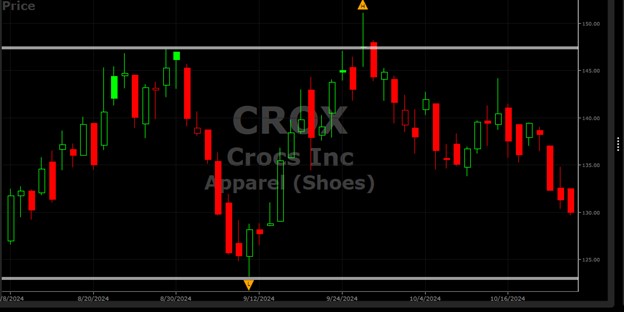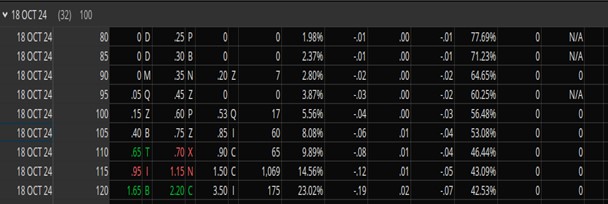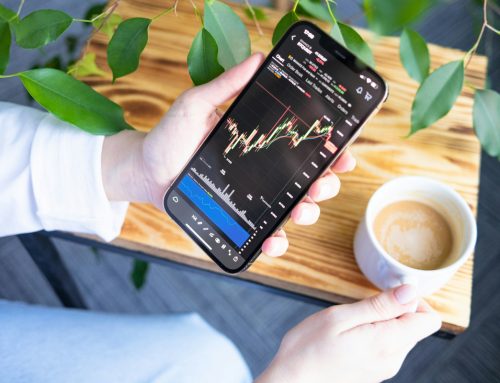Written By John Lindahl
In our last article, we discussed the four types of Vertical Spread trades. Today we are discussing the combination of the two credit trades, a bull put and a bear call, which when combined formulate an Iron Condor.
Iron Condor trades are used when the outlook of an equity is neutral or in layman’s terms, the stock is moving sideways. It is a credit trade that uses the sale and purchase of both call and put spreads.
Figure 1 illustrates the price action for Crocs (CROX) from August 8. 2024 through October 24, 2024. As depicted in the figure, CROX is cycling between a low of $123 and a high of $151. The two white lines on the graph denote the Support and Resistance lines. The Support line is drawn at $123, and the Resistance line is drawn at $147.
What are Support and Resistance Lines
Support Lines
When prices fall, while it can be for an abundance of reasons, the age-old prophecy of supply and demand rears its’ head and when the supply is greater than the demand, prices will drop until they become attractive to buyers again. When this happens, demand once again equals supply, and the prices will stop falling. This point is what is called support. Support indicates a point or zone whereby buyers are looking to purchase stock again.
Resistance Lines
Resistance acts in a similar but opposite action than support. In this case, the demand is greater than the supply and causes prices to rise. The prices will continue to rise until the demand equals the supply. In this case, owners are looking to sell and take their profits, and new buyers are viewing the price as too high to open a new position. This point is called resistance. Resistance is usually followed by a downward movement in the stock.
The Importance of Support and Resistance Lines
When an equity is neutral and moving sideways, the support and resistance lines form a boundary for the predicted high and low prices. When initiating an Iron Condor trade, we want to set our short strike prices outside of this boundary as we do not want our short puts or short calls to be breached.
Based on the neutral action, we will combine a bull put and a bear call to establish the Iron Condor trade in the following manner. It is important to remember that these are both credit trades, meaning that we are selling our puts and calls closer to the money than where we are purchasing our long protective puts and calls. Since our short puts and calls are closer to the money, they will carry a higher premium than the long puts and calls and thus we will achieve a credit trade.
Trade Setup on September 16th for October 18th Monthly Expiration
Bull Put – Figure 2 delineates the Put data respectively for the CROX option chain on Sept. 16, 2024, for the Oct. 18th expiration date. For the purposes of this example, we will use the midpoint of the Bid and Ask to set our prices.
STO (Sell to Open) October 18th Strike 120 @ a credit of $1.90
BTO (Buy to Open) October 18th Strike 115 @ a debit of $1.05
Net Credit for Bull Put = $0.85
Max Risk for Bull Put = Spread minus Net Credit = $5.00 – $0.85 = $4.15
Bear Call – Figure 3 delineates the Call data respectively for the CROX option chain on Sept. 16, 2024, for the Oct. 18th expiration date.
STO October 18th Strike 150 @ a credit of $1.20
BTO October 18th Strike 155 @ a debit of $0.70
Net Credit for Bear Call is $0.50
Max Risk on this side is Spread minus Net Credit = $5.00 – $0.50 = $4.50
Net Data for Iron Condor
Spread – $5.00
Net Credit = Net Credit Sum of Bull Put and Bear Call = $1.35
Max Risk = The side with the greater risk (wider range) minus Net Credit. In our example above this would be bear call side and would be $4.50 – $1.35 = $3.15
Max Profit = Net Credit at Expiration = $1.35
Reward Analysis
The Max Reward on an Iron Condor appears at the Expiration Date where the options expire Out of the Money and thus worthless. In this case the trader keeps the net premium received and that is how profit can be made in a neutral market. It is often not the best course of action to wait for the expiration as we are never certain that the stock will not breach the short strikes.
Vectorvest has done extensive back testing on Iron Condors and has determined that the best way to profit from the Iron Condor trades consistently is to buy back the spreads when 25% of your max profit has been reached prior to expiration. Iron Condors are considered a “Theta” trade. Theta is a Greek that measures the decay on the options premium as you get closer to expiration. Since we are looking to buy back the spread at a lower value than we sold it, Theta is your “friend” in any credit trade. In the case of the CROX example, this would equate to buying back the spread for approximately $0.95 where we would realize a profit of $0.35 per share.
Evaluating Trade Candidates
When looking for good Iron Condor trade candidates, the following criteria should be considered.
- Look for equities that have a delta less than 20
Delta is one of the “Greeks” which we will explore more thoroughly in a future session. Delta measures the change in the premium of an option based on a $1.00 move of the underlying stock. The volatility of the stock has a large effect on the delta. In an Iron Condor trade, we are looking for neutral stocks with low volatility and a low delta. Delta values range from -1 to 0 for puts and 0 to 1 for calls. When we are looking for Iron Condor candidates, we are looking for delta values less than 0.2 for calls and greater than -0.2 for puts.
- The trade should be delta neutral which means the delta for all four legs should sum up between plus or minus 0.08
To ensure that we are neutral on where we place our strikes, we sum up the deltas for the four legs of the bear call and bull put and are looking for that number to be between plus or minus 0.08. Note the put deltas will be negative numbers and the call delta will be positive.
- Do not consider equities that have Earnings or Announcements that could cause a spike in price during the duration of the trade
Be aware of events or announcements that can cause the underlying equity to spike up or down. Examples of these events or announcements might be earnings or in the case of a pharmaceutical stock, an announcement on a drug trial. If these events or announcement are scheduled to occur prior to the expiration of the Iron Condor, it is suggested to avoid the trade.
- The ADX technical indicator should be under 20
ADX is a technical indicator that measures the strength of a trend. The value of ADX ranges between 0 and 100. Equities that have a value greater than 20 are considered trending (either up or down) and equities with an ADX below 20 are considered neutral.
- The ATR should be below the midpoint of the historical values.
The ATR or Average True Range indicator averages the distances between the highs and lows for the last 14 days/bars. Verify that ATR is at its lower levels of this average. To do this, look at the historical high and low points. determine a mid-point and verify that the ATR value is below the midpoint.
- Set the short strikes above Resistance and below Support
When making credit trades such as a bull put or bear call, the trades will be successful if the short strikes are not breached. An Iron Condor trade is profitable when the underlying equity remains between the two short strikes but breaches neither. To increase your odds of success, the short strikes should be put outside of the Support and Resistance lines.
In summary, Iron Condors are great trades in a neutral market and allow traders to make money when equities are not moving much in either direction. This trade is a combination of the bull put and the bear call and can easily be adjusted, which will be a discussion in a future article. Next week, we will close out our Vertical Spreads articles with a session on Bull Calls and Bear Puts, which are both Vertical Debit Spreads
Want These Types of Insights at Your Fingertips so You Can Win More Trades?
Use VectorVest to analyze any stock free. VectorVest is the only stock analysis tool and portfolio management system that analyzes, ranks and graphs over 18,000 stocks each day for value, safety, and timing and gives a clear buy, sell or hold rating on every stock, every day.
Before you invest, check VectorVest! Click here to ANALYZE ANY STOCK FREE and see our system in action!












Leave A Comment